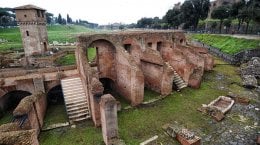Official Reseller Rome and Vatican – Jubilee 2025
Carcer Tullianum
The Tulliano Prison, also known as Carcere Mamertino, is the oldest prison in Rome, located for its historical importance in the heart of the city, near the Via Sacra nel Foro.
Overlooking of the Roman Forum, for more than 3,000 years it has been one of the most precious architectural and historical treasures of the capital.
History and architecture of the Tullianum Prison
The Tulliano Prison, also known as Carcere Mamertino, is the oldest prison in Rome, located for its historical importance in the heart of the city, near the Via Sacra nel Foro. Overlooking of the Roman Forum, for more than 3,000 years it has been one of the most precious architectural and historical treasures of the capital. Dating back to the Republican age, it witnessed the incarcerations of the main enemies and traitors of the Roman people, as well as of many illustrious prisoners and important figures linked to the Christian events of Ancient Rome.
The complex is located below the Church of St. Giuseppe dei Falegnami, dating back to the 16th century, in that area of the Roman Forum historically dedicated to carrying out judicial activities. The Tulliano Prison was built during the reign of the fourth King of Rome, Anco Marzio, known for having reigned in Ancient Rome for 25 years, before dying of natural causes.
The etymology of its name, tullianum, apparently derives from tullus, a water spring, a term indicative of the actual presence of a real water source within the structure.
Giugurta, was sentenced to die right in these waters, as can be seen also from the numerous ancient writings that stop to describe the Tullianum Prison as a lugubrious and frightening place, erected above a source of water still active today.
The imprisonment, prior to the death sentence, could be both long and short, depending on the seriousness of the crimes committed against the State or the Roman people.
Among the most famous people condemned to death in the Tullianum Prison there is Vercingetorix, Prince of Gallia, beheaded after six years of imprisonment, but also the apostles Saint Peter and Paul, imprisoned in the Neronian era and the conspirators of Lucius Sergio Catilina, senator and Roman militant known for having tried to subvert the oligarchy at the base of the ancient Roman Republic.
Stories of Christian tradition
The imprisonment of St. Peter is told by the Christian tradition with an incredible feat, according to which the apostle, through the use of a stick, made water come out of the foundations of the prison to baptize the other prisoners, as well as the guardians of the Process and Martinian cells, who also died as martyrs. Another curious legend also tells that St. Peter, in the descent towards the cells, fell, beating his head against the stone wall, leaving the imprint of his head on a rock, still preserved and protected by a wire mesh.
These stories, although not yet confirmed by history, have given rise since ancient times to a strong response from the believing people. For this reason, in the 8th century the prison was the protagonist of a true work of Christianization, which in effect converted it into a place of worship, with the construction of the Church of St. Peter and St. Paul in Prison and the creation of frescoes and paintings on the wall.
Thus, the Church was born, derived from the lowest cell of the Tullianum and still today a destination of pilgrimage for Christians from all over the world.
It is precisely in conjunction with this work of Christianization that the Tullianum Prison begins to be called also the Mamertine Prison, becoming a reference point for all believers and further strengthening the rich history of a such a unique building.
Overview of the architectural structure of the Tullianum Prison
The architectural structure of the prison is characterized by the presence of a series of caves, which are dug on two overlapping different levels, near the southern slopes of the Campidoglio.
The most ancient and profound level, the tullianum, is of archaic origin and has a semicircular shape, and was obtained by digging directly inside the enclosing walls built to protect the Campidoglio.
The second floor, instead, called Carcer, was superimposed on the first in the Republican age, and was used at this time as a place of confinement for those prisoners who were waiting to be executed.
A flight of stairs allows access to the oldest part of the structure, while an entrance probably built around the 2nd century leads to the trapezoidal-shaped room that characterizes the Carcer, overflowed by splendid barrel vaults that rise on sturdy walls built in tuff.
They could probably enter the main entrance through a small door that is still present on the upper floor of the prison; the access trapdoor, which today is covered by a metal grate, is of recent construction, as well as the floor level in which it is housed, in fact both date back to at least the 18th century.
The currently visible façade of the building can be traced back to the imperial age and covers the oldest one, originally built, like the walls, through the use of large blocks of magmatic rock.
Starting from 2000, for ten years, the Archaeological Superintendence of the city of Rome had dealt in depth with the redevelopment of the structure of the Tullianum prison, reopening the building to the public only in 2010, after various phases of study and analysis and several restoration interventions.
The intent was to offer the public the opportunity to observe closely what are the environments of a unique architectural building, as well as the possibility of closely contemplating the frescoes and other symbolic elements of the worship of the Christian Church still kept inside the prison.
08.30 a.m. – 4.30 p.m. (from the last Sunday of October until the last Saturday of March)
08.30 a.m. – 6.30 p.m. (from the last Sunday of March to August 31)
08.30 a.m. – 6.00 p.m. (from 1 to 30 of September)
08.30 a.m. – 5.30 p.m. (from October 1 to the last Saturday of October)
The Ticket office close an hours before the closing time.
Metro
Line B and B1, Colosseo stop
Bus
Fori Imperiali / Campidoglio stop, bus n.51 and n.85
Teatro Marcello stop, bus n.715 and n.716
Tram
8, Piazza Venezia stop / last stop
Check the stops of the Open Top Bus Vatican & Rome on the map in order to find the closest stop to the attraction you are interested in visiting;
Alternatively, consult https://www.google.com/maps for information on public transport.
Remember: with Omnia 72h you have access to all means of public transport of Rome.
Colosseum, Roman Forum, Palatine






